Celebrating 15 Years of Working With Our Local Community
The Maui Nui Marine Resource Council has much to be thankful for as we look back over the last year. We celebrated 15 years of working with our community partners to protect Maui’s nearshore environment. Thanks to generous donors and grant funding, we added new program areas, moved projects toward completion, and much more. Below are some highlights from 2022.
You can download a .pdf of the report here.
Reef Friendly Landscaping
Our Reef Friendly landscaping program made a lot of progress over the past year and is comprised of three programs which include our “compost tea” test plot program; Reef Friendly Landscaping certification program for private properties; and collaboration, education, and outreach.
The “compost tea” test plot program worked with four community partners: the County of Maui Parks and Recreation; Wailea Community Association; Mākena Golf and Beach Club; and Environmental Solutions Maui. Environmental Solutions Maui is a local business based in Hāʻiku that specializes in producing a compost tea-like product called SoilThrive. SoilThrive is a liquid, biological soil amendment that works to re-establish soil microbiology and support plant health. With the new funding, we are continuing to expand those test plots to other properties around south Maui, including Kamaole Sands.
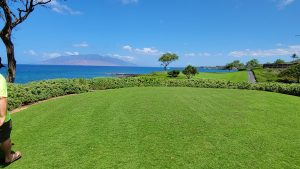
Success at one of the RFL test plots
The certification program certifies properties that are transitioning away from chemical and conventional landscaping practices to organic landscaping practices. The certification program requires properties to meet with our organic landscaping consultant, Duane Sparkman, and remove all required chemicals from their property. The landscaping manager signs a commitment and agrees to submit a list of products being used on the property, as well as report any use of chemicals in need of pest outbreaks when organic treatments cannot remediate the issue.
We also convened an expert working group on Maui, which evolved into another test plot program funded by the Hawai’i Tourism Authority (HTA) Destination Management Action plan through the Maui Visitors and Convention Bureau (MVCB). The working group includes participants from West Maui Ridge to Reefs Initiative, Beyond Pesticides, Edaphic Consulting, and ES Maui. MVCB and HTA pledged to fund 8 test plots for a total of $40,000. Test plots are located at the Palms at Wailea, Andaz, Maui Ocean Center, Hyatt Regency, and more.
Mauka to Makai – Ungulate Fencing
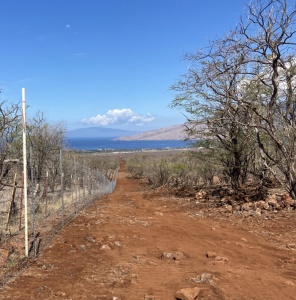
Ungulate fencing helps farmers control feral deer and goat populations and reduce runoff.
The MNMRC worked with Kaonoulu Ranch to have 1800 linear ft (or 1/3rd of a mile) of 8 ft tall ungulate fencing installed running mauka to makai. This is in addition to extensive fencing efforts that the ranch and other partners are working together to install. Every little or big bit helps. This area is adjacent to gulches that contribute sediment and excess nutrients to the ocean when it rains.
Fencing is paired with the harvest of the invasive axis deer from within the perimeters. The fencing helps control deer herd movements to preferred areas and makes harvesting easier. This combined effort will reduce erosion and allow grasses to regrow and stabilize the soil. An added bonus is that fire breaks can be made at the same time as the fencing is installed.
Mauka to Makai – Pohakea and Maalaea
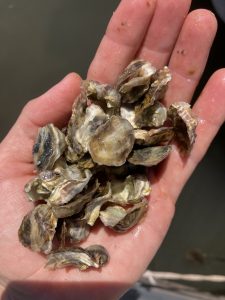
Juvenile oysters filter sediment from the waters of Ma’alaea Harbor
In early 2022 we completed our vetiver planting project in Pohakea, adding this drought-resistant grass to vulnerable erosion areas to mitigate sediment flow into Maalaea Bay during heavy rain events. On the makai side, our oyster bioremediation project is helping to clean the water in the bay. The oysters are showing promising growth, and with this growth comes the ability to filter more water – up to 50 gallons each day for an adult oyster. Three-thousand juvenile oysters were added in late 2022.
Our oysters come from UH Hilo’s Pacific Aquaculture and Coastal Resource Center, specifically bred as triploids, meaning they have a third set of chromosomes that helps to prohibit them from reproducing, and instead focusing their energy on growing big and filtering lots of water. This also helps make them safe to use in our waters as they don’t pose any threat to native species.
Our MNMRC staff will continue to monitor the oysters every 2 weeks and work with the State of Hawai’i for permits and harbor permissions.
Sunscreen
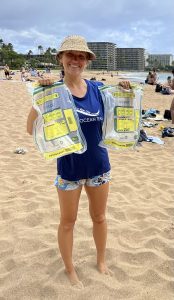
MNMRC Project Manager, Meredith Beeson, holding samples that were tested for sunscreen residues.
The new ban on non-mineral sunscreen took effect on October 1, 2022, and after months of campaigning, we were excited to see the ban go through. We are working with Dr. Craig Downs to determine the effectiveness of this ban. We took water samples from 5 Maui beaches in September before the ban went into effect, and we will do the same in 2023 to compare sunscreen chemical levels before and after the ban. If we see a decrease in the banned chemicals, we will know this type of legislation is effective, and if not, MNMRC and its partners will know that more public outreach is needed to decrease these contamination levels and protect our coral reef ecosystems.
Hui O Ka Wai Ola
Hui O Ka Wai Ola is a community-based water quality monitoring program, launched and conducted by Maui Nui Marine Resource Council, The Nature Conservancy, and West Maui Ridge to Reefs Initiative in partnership with the State of Hawaii Department of Health Clean Water Branch.
Hui O Ka Wai Ola currently has 30 volunteers that help us collect coastal ocean water samples every three weeks along 29 sites of leeward Maui. In 2022 alone, the Hui volunteers tested 493 samples! The well-trained volunteers test physical parameters including temperature, salinity, pH, dissolved oxygen, and turbidity in a mobile lab on site. They also help us filter and prepare samples that we ship to the SOEST Lab for Analytical Biogeochemistry at UH Mānoa for deeper analysis of chemical parameters in the water. Those chemical parameters include organic and inorganic nutrients such as Total Nitrogen, Total Phosphorus, Phosphate, Silicate, Nitrite-Nitrate Nitrogen (NNN), and Ammonia.
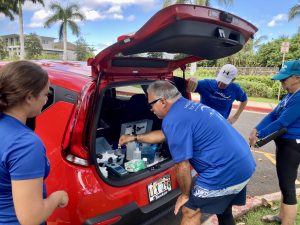
Hui O Ka Wai Ola volunteers analyze water samples with the Hui’s mobile water quality testing lab.
Since the monitoring program launched in 2016, Hui O Ka Wai Ola has collected over 3,200 water samples along the leeward coast of Maui. This accumulation of data has allowed us to get an understanding of the ocean chemistry story of our sites over the past six years. The current trends we are seeing include high turbidity followed by high nutrient levels in West Maui with all 19 of our current sites exceeding the state standard for turbidity set by the Department of Health. Much of this trend in increased turbidity in West Maui can be attributed to coastal erosion due to sea level rise. In South Maui, we are seeing that the issues are swapped with high nutrient levels as the primary concern followed by high turbidity. In South Maui, all 13 sites exceed the state standard for nutrients as a result of current agricultural and wastewater practices within the South Maui watersheds. We’ve also seen South Maui heavily impacted by big spikes in turbidity from major storm runoff and flooding over the past two years.
In light of the major rain events we’ve been seeing recently, we’ve just launched our Brown Water Watch project. In this project, we are encouraging anyone with a drone, camera, or cell phone to capture images of brown water events and send them to our email at [email protected] or tag us on Instagram or Facebook @brownwaterwatch. We are trying to collect visual data on these brown water events and, with your permission, we will share your photos with the Department of Health and our social media accounts. This is a great way to get involved with our work if you aren’t able to volunteer your time or donate to keep our work going.
All of our data is made publicly available. You can download our dataset as well as our 2016-2021 Coastal Water Quality Report where you can read more about trends, hotspots, and other findings at huiokawaiola.com.
Hui O Ka Wai Ola is committed to continuing to monitor our coastal water trends and working with our partnering organizations to improve our coastal water quality where we can.
AquaLink Buoys
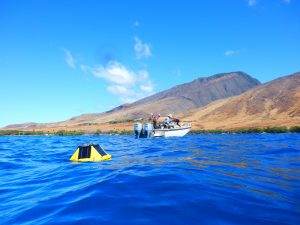
The Olowalu Aqualink buoy and smart mooring system provide realtime data about water conditions.
We have deployed three Aqualink buoys in the ocean near Kalama Park in Kula Kai (Kihei), Ma’alaea Bay, and Olowalu. These satellite-linked buoys record ocean temperatures just below the surface and also at the same depth as most of our corals. We can watch this real-time data and know if there is a threat of a bleaching event.
Along with temperature, they also measure wind direction and speed and wave height, direction, and frequency at the surface. Best of all, this live data is available to the public anytime, at https:aqualink.org. We encourage all our water-user partners to take advantage of these condition reports.
https://aqualink.org/sites/2188 Kalama
https://aqualink.org/sites/2185 Maalaea
https://aqualink.org/sites/1868 Olowalu
Outreach and Education
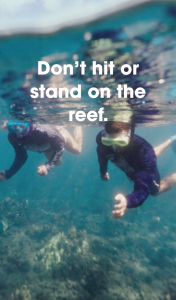
A still from a 10-second reef etiquette video shown at Kahului Airport and on social media platforms.
With support from the County of Maui, MNMRC has been targeting visitors to educate them about marine life and conservation here in Maui.
This all starts when visitors first arrive on the island, with ads at the Kahului airport. On the windows in the southwestern terminal, we had sign messaging about reef health, snorkel tips, and sunscreen use. Down in baggage claim, we had 4 short videos that engage viewers and encourage them to respect the ocean here. The videos play on a rotation above the baggage claim belts for visitors to watch while waiting for their luggage. The ads feature reef-friendly messaging including Stand only on sand, Coral is alive – Keep fins up Coral is Alive- Keep your Paddle Up, Mineral only sunscreen, Wear a rashguard – Use less Sunscreen, Protecting Coral Reefs, Welcome to Maui – Enjoy wildlife from a distance. The ads are also heavily promoted on Spectrum TV, and on our Facebook and Instagram social media platforms using geotargeting to reach our target audience.
Financial Summary 2022
Over the past year, MNMRC again demonstrated our ability to provide the greatest impact for coral reefs with every dollar raised. In 2022, we spent 79% of our income on program services. According to CharityWatch, a charity organization devoting 75% of its income to program services is considered “highly efficient.” We are proud to have exceeded this standard which would qualify us for a CharityWatch rating of “Excellent.” (Note that the numbers provided here are preliminary as of March 2023 and will be updated when our final accounting comes in for the year.)
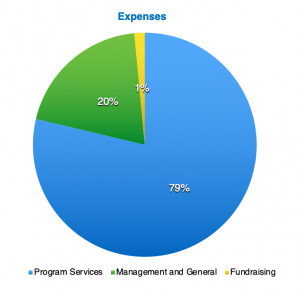
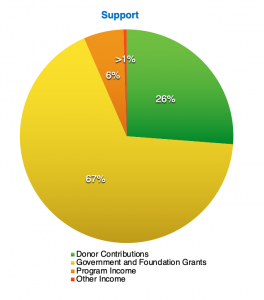
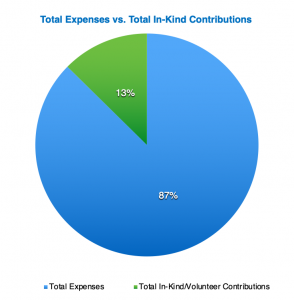
Looking Forward 2023
This coming year sees the continuation of many of our longer-term projects such as Reef Friendly Landscaping, ungulate fencing to reduce erosion and sediment pollution and, of course, the Hui O Ka Wai Ola will keep keeping our public informed about water quality in west and South Maui. New efforts include the start of coral reef monitoring along the Kihei reef tract from Kihei to Makena, the growth of RFL to include homeowner participation, and increased efforts to address flooding in north Kihei. We continue to appreciate and rely on the support of our donors who allow us to engage in the work to support clean water, abundant fish, and healthy coral reefs on Maui. Thank you for supporting us last year and please consider continuing to support the council in 2023.


